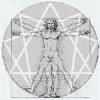Parts of centers hardly came into these talks. G. said that centers were divided into positive and negative parts, but he did not point out that this division was not identical for all the different centers. Then he said that each center was divided into three parts or three stories which, in their turn, were also divided into three; but he gave no examples, nor did he point out that observation of attention made it possible to distinguish the work of parts .of centers. All this and much else besides was established later. For instance, although he undoubtedly gave the fundamental basis for the study of the role and the significance of NEGATIVE EMOTIONS, as well as methods of struggling against them, referring to non-identification, non-considering, and not expressing NEGATIVE EMOTIONS, he did not complete these theories or did not explain that NEGATIVE EMOTIONS were entirely unnecessary and that no normal center for them existed. Fragments: Three
“Because,” G. answered, “laughter relieves us of superfluous energy, which, if it remained unused, might become negative, that is, poison. We always have plenty of this poison in us. Laughter is the antidote. But this antidote is necessary only so long as we are unable to use all the energy for useful work. It is said of Christ that he never laughed. And indeed you will find in the Gospels no indication or mention of the fact that at any time Christ laughed. But there are different ways of not laughing. There are people who do not laugh because they are completely immersed in NEGATIVE EMOTIONS, in malice, in fear, in hatred, in suspicion. And there may be others who do not laugh because they cannot have NEGATIVE EMOTIONS. Understand one thing. In the higher centers there can be no laughter, because in higher centers there is no division, and no ‘yes’ and ‘no.’” Fragments: Eleven

